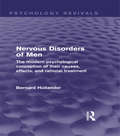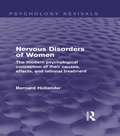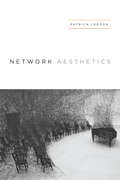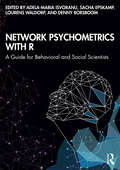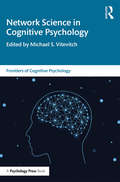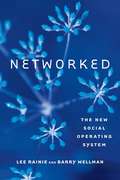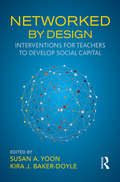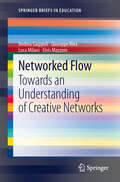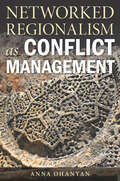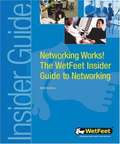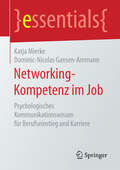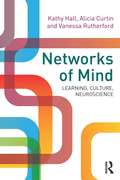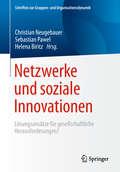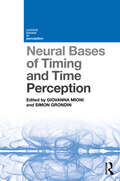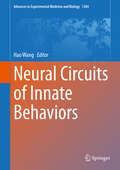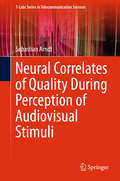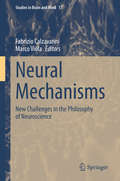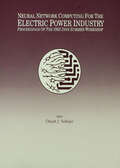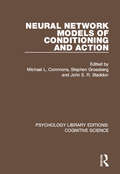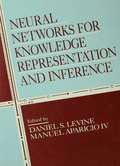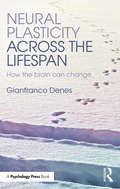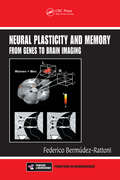- Table View
- List View
Nervous Disorders of Men: The Modern Psychological Conception of their Causes, Effects, and Rational Treatment (Psychology Revivals)
by Bernard HollanderBorn in Vienna in 1864, Bernard Hollander was a London-based psychiatrist. He is best known for being one of the main proponents of phrenology. This title, originally published in 1916, looks at ‘the numerous nervous illnesses of men, in which the mental factor plays a large part, and which are known as functional disorders, to distinguish them from organic diseases’. He looks at the role of psychotherapy as an emerging treatment for these disorders. There is also a companion volume which looks at the Nervous Disorders of Women.
Nervous Disorders of Women: The Modern Psychological Conception of their Causes, Effects and Rational Treatment (Psychology Revivals)
by Bernard HollanderBorn in Vienna in 1864, Bernard Hollander was a London-based psychiatrist. He is best known for being one of the main proponents of phrenology. This title, originally published in 1916, looks at ‘the numerous nervous illnesses of women, in which the mental factor plays a large part, and which are known as functional disorders, as distinguished from organic diseases’. He looks at the role of psychotherapy as an emerging treatment for these disorders. There is also a companion volume which looks at the Nervous Disorders of Men.
Network Aesthetics
by Patrick JagodaThe term "network" is now applied to everything from the Internet to terrorist-cell systems. But the word's ubiquity has also made it a cliché, a concept at once recognizable yet hard to explain. Network Aesthetics, in exploring how popular culture mediates our experience with interconnected life, reveals the network's role as a way for people to construct and manage their world--and their view of themselves. Each chapter considers how popular media and artistic forms make sense of decentralized network metaphors and infrastructures. Patrick Jagoda first examines narratives from the 1990s and 2000s, including the novel Underworld, the film Syriana, and the television series The Wire, all of which play with network forms to promote reflection on domestic crisis and imperial decline in contemporary America. Jagoda then looks at digital media that are interactive, nonlinear, and dependent on connected audiences to show how recent approaches, such as those in the videogame Journey, open up space for participatory and improvisational thought. Contributing to fields as diverse as literary criticism, digital studies, media theory, and American studies, Network Aesthetics brilliantly demonstrates that, in today's world, networks are something that can not only be known, but also felt, inhabited, and, crucially, transformed.
Network Psychometrics with R: A Guide for Behavioral and Social Scientists
by Denny Borsboom Adela-Maria Isvoranu Sacha Epskamp Lourens J. WaldorpA systematic, innovative introduction to the field of network analysis, Network Psychometrics with R: A Guide for Behavioral and Social Scientists provides a comprehensive overview of and guide to both the theoretical foundations of network psychometrics as well as modelling techniques developed from this perspective. Written by pioneers in the field, this textbook showcases cutting-edge methods in an easily accessible format, accompanied by problem sets and code. After working through this book, readers will be able to understand the theoretical foundations behind network modelling, infer network topology, and estimate network parameters from different sources of data. This book features an introduction on the statistical programming language R that guides readers on how to analyse network structures and their stability using R. While Network Psychometrics with R is written in the context of social and behavioral science, the methods introduced in this book are widely applicable to data sets from related fields of study. Additionally, while the text is written in a non-technical manner, technical content is highlighted in textboxes for the interested reader. Network Psychometrics with R is ideal for instructors and students of undergraduate and graduate level courses and workshops in the field of network psychometrics as well as established researchers looking to master new methods.
Network Science in Cognitive Psychology (Frontiers of Cognitive Psychology)
by Michael S. VitevitchThis volume provides an integrative review of the emerging and increasing use of network science techniques in cognitive psychology, first developed in mathematics, computer science, sociology, and physics. The first resource on network science for cognitive psychologists in a growing international market, Vitevitch and a team of expert contributors provide a comprehensive and accessible overview of this cutting-edge topic. This innovative guide draws on the three traditional pillars of cognitive psychological research–experimental, computational, and neuroscientific–and incorporates the latest findings from neuroimaging. The network perspective is applied to the fundamental domains of cognitive psychology including memory, language, problem-solving, and learning, as well as creativity and human intelligence, highlighting the insights to be gained through applying network science to a wide range of approaches and topics in cognitive psychology Network Science in Cognitive Psychology will be essential reading for all upper-level cognitive psychology students, psychological researchers interested in using network science in their work, and network scientists interested in investigating questions related to cognition. It will also be useful for early career researchers and students in methodology and related courses.
Networked
by Lee Rainie Barry WellmanDaily life is connected life, its rhythms driven by endless email pings and responses, the chimes and beeps of continually arriving text messages, tweets and retweets, Facebook updates, pictures and videos to post and discuss. Our perpetual connectedness gives us endless opportunities to be part of the give-and-take of networking. Some worry that this new environment makes us isolated and lonely. But in Networked, Lee Rainie and Barry Wellman show how the large, loosely knit social circles of networked individuals expand opportunities for learning, problem solving, decision making, and personal interaction. The new social operating system of "networked individualism" liberates us from the restrictions of tightly knit groups; it also requires us to develop networking skills and strategies, work on maintaining ties, and balance multiple overlapping networks. Rainie and Wellman outline the "triple revolution" that has brought on this transformation: the rise of social networking, the capacity of the Internet to empower individuals, and the always-on connectivity of mobile devices. Drawing on extensive evidence, they examine how the move to networked individualism has expanded personal relationships beyond households and neighborhoods; transformed work into less hierarchical, more team-driven enterprises; encouraged individuals to create and share content; and changed the way people obtain information. Rainie and Wellman guide us through the challenges and opportunities of living in the evolving world of networked individuals.
Networked By Design: Interventions for Teachers to Develop Social Capital
by Susan A. Yoon Kira J. Baker-DoyleNetworked by Design brings together work from leading international scholars in the learning sciences that applies social network theory to teachers’ social interactions and relationships. The volume examines the direct and indirect relationships and communities that teachers navigate, as well as the models, plans, and other interventions that allow them to exercise control over these networks. Each chapter draws from case studies or latitudinal research to investigate a different intervention and its outcomes. By presenting research conducted in a variety of scales and contexts, this book offers scholars, future teachers, and leaders diverse insights into how interventions in social capital and social networks can create impactful, meaningful teaching and learning.
Networked Flow
by Luca Milani Giuseppe Riva Elvis Mazzoni Andrea GaggioliIdentifying 'networked flow' as the key driver of networked creativity, this new volume in the Springer Briefs series deploys concepts from a range of sub-disciplines in psychology to suggest ways of optimizing the innovative potential of creative networks. In their analysis of how to support these networks, the contributing authors apply expertise in experimental, social, cultural and educational psychology. They show how developing a creative network requires the establishment of an optimal group experience in which individual intentions inform and guide collective goals. The volume represents a three-fold achievement. It develops a ground-breaking new perspective on group creativity: the notion of 'networked flow' as a bridging concept linking the neuropsychological, psychological and social levels of the creative process. In addition, the authors set out a six-stage model that provides researchers with a methodological framework (also by referring to the social network analysis) for studying the creativity traditionally associated with interpersonal contexts. Finally, the book includes perceptive analysis of the novel possibilities opened up by second-generation internet technologies, particularly in social networking, that seem destined to develop and sustain online creativity. As a wide-ranging exposition of a new direction in theoretical psychology that is laden with exciting possibilities, this volume will inform and inspire professionals, scholars and students alike.
Networked Regionalism as Conflict Management
by Anna OhanyanMost regions of the world are plagued by conflicts that are made insoluble by a confluence of complex threads from history, geography, politics, and culture. These "frozen conflicts" defy conflict management interventions by both internal and external agents and institutions. Worse, they constantly threaten to extend beyond their local geographies, as in the terrorist bombings in Boston by ethnic Chechens, or to escalate from skirmishes to full-scale war, as in Nagorno-Karabakh. Consequently, such conflicts cry out for alternative approaches to the classic, state-focused, and sovereignty-based conflict management models that are practiced in traditional diplomacy--which most often produce rather short-term, ad hoc, fragmented interventions and outcomes. Drawing upon the cases of the South Caucasus, the Western Balkans, Central America, South East Asia, and Northern Ireland, Networked Regionalism as Conflict Management offers a theoretical and practical solution to this impasse by arguing for regional collective interventions that involve a long-term reengineering of existing conflict management infrastructure on the ground. Such approaches have been attracting the attention of scholars and practitioners alike yet, thus far, these concepts have rarely involved more than simple prescriptions for regional cooperation between grassroots actors and traditional diplomacy. Specifically, says Anna Ohanyan, only the cultivation and establishment of regional peace systems can provide an effective path toward conflict management in these standoffs in such intractably divided regions.
Networking Works! The WetFeet Insider Guide to Networking
by WetFeetWetFeet has earned a strong reputation among college graduates and career professionals for its series of highly credible, no-holds-barred Insider Guides. This one is on networking, a valuable skill in any industry.
Networking-Kompetenz im Job: Psychologisches Kommunikationswissen für Berufseinstieg und Karriere (essentials)
by Katja Mierke Dominic-Nicolas Gansen-AmmannDie Autoren geben in diesem essential unter R#65533;ckgriff auf evolutions- und wirtschaftspsychologische Modelle einen #65533;berblick #65533;ber Befunde der Karriereforschung, Facetten sozialer Fertigkeit und deren Bedeutung f#65533;r Networking und Besch#65533;ftigungsf#65533;higkeit. Sie fassen Erkenntnisse sozialpsychologischer Studien zur Relevanz pers#65533;nlicher Ziele und zur aktiven Steuerung eigener Verhaltensmuster praxisnah zusammen und machen sie durch #65533;bungen karrierebezogen nutzbar. Auf Basis eines Phasenmodells geben sie Impulse zu Aufbau, Pflege und Nutzung des eigenen Netzwerks und zeigen, wie sich positive Kommunikation auf den Einzelnen sowie auf den Erfolg von Arbeitsteams auswirkt. Das essential schlie#65533;en die Autoren mit weiteren Anregungen zum individuellen Praxistransfer.
Networks of Mind: Learning, Culture, Neuroscience
by Kathy Hall Alicia Curtin Vanessa RutherfordThis ground breaking book is unique in bringing together two perspectives on learning - sociocultural theory and neuroscience. Drawing on both perspectives, it foregrounds important developments in our understanding of what learning is, where and how learning occurs and what we can do to understand learning as an everyday process. Leading experts from both disciplines demonstrate how sociocultural ideas (such as the relevance of experience, opportunity to learn, environment, personal histories, meaning, participation, memory, and feelings of belonging) align with and reflect upon new understandings emerging from neuroscience concerning plasticity and neural networks. Among the themes critically examined are the following: Mind and brain Culture Ability and talent Success and failure Memory Language Emotion Aimed at and accessible to a broad audience and drawing on both schools of thought, Networks of Mind employs case studies, vignettes and real life examples to demonstrate that, though the language of sociocultural theory and that of neuroscience appear very different, ultimately the concepts of both perspectives align and converge around some key ideas. The book shows where both perspectives overlap, collide and diverge in their assumptions and understanding of fundamental aspects of human flourishing. It shows how neuroscience confirms some of the key messages already well established by sociocultural theory, specifically the importance of opportunity to learn. It also argues that the ascendency of neuroscience may result in the marginalization of sociocultural science, though the latter, it argues, has enormous explanatory power for understanding and promoting learning, and for understanding how learning is afforded and constrained.
Netzwerke und soziale Innovationen: Lösungsansätze für gesellschaftliche Herausforderungen? (Schriften zur Gruppen- und Organisationsdynamik #12)
by Ewald E. Krainz Christian Neugebauer Sebastian Pawel Helena BiritzIm vorliegenden Sammelband Netzwerke und Soziale Innovationen wird der Frage nachgegangen, welchen Beitrag Netzwerke bei der Entstehung und Entwicklung von sozialen Innovationen leisten können und wie dies zu Veränderungen in der Gesellschaft führt. In einem Mix aus theoretischen und reflexiven Beiträgen als auch der Darstellung von spannenden Initiativen und Projekten – von den InitiatorInnen selbst anschaulich geschildert –, wird die Thematik praxisorientiert aufgearbeitet. Sowohl PraktikerInnen als auch WissenschaftlicherInnen erhalten wertvolle Hinweise für die Organisation und Entwicklung sozialer Innovationen.
Neue Medien und kindliche Entwicklung: Ein Überblick für Therapeuten, Pädagogen und Pädiater (essentials)
by Martina Zemp Guy BodenmannDieses Essential zeigt, welche Konsequenzen die Nutzung von Fernseher, Computer und Internet für Kinder und Jugendliche hat - und was Fachleute Eltern raten können. Aus wissenschaftlicher Perspektive wird deutlich, dass die Nutzung von gewaltbetonten Medien ein Prädiktor für aggressives Verhalten bei Heranwachsenden ist, neuen Medien ein Suchtpotenzial innewohnt und exzessive Mediennutzung den kindlichen Schulleistungen abträglich sein kann. Entscheidend sind jedoch die Häufigkeit der Nutzung und der Medieninhalt. Vor diesem Hintergrund stehen Eltern in der Pflicht, klare Strukturen bezüglich Form, Inhalt und Dauer der Mediennutzung ihrer Kinder durchzusetzen.
Neue Stimmen in der psychosozialen Forschung
by Stephen FroshDie psychosozialen Studien im Vereinigten Königreich sind ein vielfältiger Arbeitsbereich, der sich durch Innovation in Theorie und empirischer Forschung auszeichnet. Die außerordentliche Lebendigkeit dieses Bereichs zeigt sich in diesem Buch, das die Forschungsarbeiten der Abteilung für psychosoziale Studien an der Birkbeck University of London, UK, vorstellt und drei zentrale Bereiche der Disziplin beleuchtet: Psychoanalyse, Ethik und Reflexivität sowie Widerstand. Das Buch befasst sich auf psychosoziale Weise mit einer Vielzahl von Themen, von der Sozialkritik der Psychoanalyse über postkoloniale und Queer-Theorie bis hin zu Studien über psychische Gesundheit und Widerstand gegen Diskriminierung. Diese "New Voices in Psychosocial Studies" bieten eine kohärente und doch weitreichende Darstellung der Forschung, die in einem "Dialekt" des neuen Terrains der psychosozialen Studien stattgefunden hat, und ein Agenda-setzendes Manifest für einige der Arten von Arbeit, die die fortgesetzte Kreativität der psychosozialen Studien in der nächsten Generation sicherstellen könnten. Dieses Buch zeigt die kontinuierliche Entwicklung der psychosozialen Studien als innovative, kritische Kraft und wird sowohl neue als auch etablierte Forscher aus allen Bereichen inspirieren, die ihren transdisziplinären Ansatz beeinflussen, einschließlich: kritische Psychologie und radikale Soziologie, feministische, queere und postkoloniale Theorie, kritische Anthropologie und Ethnographie und Phänomenologie.
Neugierig altern und gut leben: Offen – lebendig – lebensfroh
by Sven SeiboldSie leben 20 Jahre länger als frühere Generationen. Dieses Sachbuch hilft Ihnen, die gewonnenen Jahre zu nutzen und Ihr Leben im Alter aktiv zu gestalten. Unterscheiden Sie zwischen den Veränderungen, die Sie aktiv beeinflussen können, und solchen, an die Sie sich geschickt anpassen sollten. Ihre Lebensqualität im Alter ist höher, wenn Sie bewusst entscheiden, was gutes Leben für Sie persönlich bedeutet – jenseits von gesellschaftlichen Störfeuern wie Jugendwahn oder Altersdiskriminierung. Das Buch hilft, im Alter lebendig, neugierig und lebensfroh zu bleiben. Aus dem Inhalt: Versöhnen Sie sich mit Ihrer Biografie – gehen Sie respektvoll mit sich um. Orientieren Sie sich an positiven Vorbildern – gutes Altern kann man lernen. Bleiben Sie neugierig – lassen sich von den Chancen des Alters inspirieren. Steigern Sie Ihre Lebensfreude im Alter. Seien Sie fürsorglich zu sich – bleiben Sie körperlich, geistig, emotional und sozial gesund. Treffen Sie wichtige Entscheidungen selbst. Über den Autor: Sven Seibold ist Psychologe und Professor für Wirtschaftspsychologie an der Hochschule Hannover. Seine Arbeitsschwerpunkte sind Entscheidungen, Stress und Persönlichkeit. Er interessiert sich dafür, wie Menschen denken und fühlen, sowie dafür, warum sich Menschen so oft irrational verhalten und wie man das verändern kann. In vielen seiner Arbeiten geht es um Unterschiede zwischen Menschen und darum, wie Menschen lernen, klug zu entscheiden und sich an Veränderungen geschickt anzupassen.
Neural Bases of Timing and Time Perception (Current Issues in Perception)
by Simon Grondin Giovanna MioniNeural Bases of Timing and Time Perception provides a cutting-edge overview of the main contemporary neuroscientific methods and findings in this burgeoning field.Featuring an international collection of leading researchers, this text reports the main methodological tools available to address important questions in the field, what discoveries these tools led to, and what avenues remain to be explored. The book provides concise descriptions of the latest neuroscientific developments about time perception and temporal processing (for instance, how to use TMS or tDCS to study time judgments); and signposts avenues for clinicians to develop new insights for understanding pathologies (as in the case of schizophrenia, for instance) from a temporal perspective.This book will appeal to anyone interested in how we perceive the passing of time, whether from an academic or clinical background.
Neural Circuits of Innate Behaviors (Advances in Experimental Medicine and Biology #1284)
by Hao WangThis book summarizes the latest research findings in the neurocircuitry of innate behaviors, covering major topics such as innate fear, aggression, feeding, reward, social interaction, parental care, spatial navigation, and sleep-wake regulation. For decades, humans have been fascinated by wild animals’ instincts, like the annual two-thousand-mile migration of the monarch butterfly in North American, and the “imprint” behavior of newborn birds. Since these instincts are always displayed in stereotypical patterns in most individuals of a given species, the neural circuits processing such behaviors must be genetically hard-wired in the brain. Recently, with the development of modern techniques, including optogenetics, retrograde and anterograde virus tracing, and in vivo calcium imaging, researchers have been able to determine and dissect the specific neural circuits for many innate behaviors by selectively manipulating well-defined cell types in the brain. This book discusses recent advances in the investigation of the neural-circuit mechanisms underlying innate behaviors.
Neural Correlates of Quality During Perception of Audiovisual Stimuli
by Sebastian ArndtThis book presents a new approach to examining the perceived quality of audiovisual sequences. It uses electroencephalography (EEG) to explain in detail how user quality judgments are formed within a test participant, and what the physiological implications might be when subjects are exposed to lower quality media. The book redefines the experimental paradigms of using EEG in the area of quality assessment so that they better suit the requirements of standard subjective quality testing, and presents experimental protocols and stimuli that have been adjusted accordingly.
Neural Mechanisms: New Challenges in the Philosophy of Neuroscience (Studies in Brain and Mind #17)
by Fabrizio Calzavarini Marco ViolaThis volume brings together new papers advancing contemporary debates in foundational, conceptual, and methodological issues in cognitive neuroscience. The different perspectives presented in each chapter have previously been discussed between the authors, as the volume builds on the experience of Neural Mechanisms (NM) Online – webinar series on the philosophy of neuroscience organized by the editors of this volume. The contributed chapters pertain to five core areas in current philosophy of neuroscience. It surveys the novel forms of explanation (and prediction) developed in cognitive neuroscience, and looks at new concepts, methods and techniques used in the field. The book also highlights the metaphysical challenges raised by recent neuroscience and demonstrates the relation between neuroscience and mechanistic philosophy. Finally, the book dives into the issue of neural computations and representations. Assembling contributions from leading philosophers of neuroscience, this work draws upon the expertise of both established scholars and promising early career researchers.
Neural Network Computing for the Electric Power Industry: Proceedings of the 1992 Inns Summer Workshop (INNS Series of Texts, Monographs, and Proceedings Series)
by Dejan J. SobajicPower system computing with neural networks is one of the fastest growing fields in the history of power system engineering. Since 1988, a considerable amount of work has been done in investigating computing capabilities of neural networks and understanding their relevance to providing efficient solutions for outstanding complex problems of the electric power industry. A principal objective of a power utility is to provide electric energy to its customers in a secure, reliable and economic manner. Toward this aim, utility personnel are engaged in a variety of activities in areas of supervisory control and monitoring, evaluation of operating conditions, operation planning and scheduling, system development, equipment testing, etc. Over the past decades significant advances have been made in the development of new concepts, design of hardware and software systems, and implementation of solid-state devices which all contributed to the steadily improving power system performance that we are experiencing today. Advanced information processing technologies played an important role in these development efforts. Members of the Special Interest Group for Power Engineering of the INNS recognized the need for bringing together leading researchers in the field of neurocomputing with experts from power utilities and manufacturing companies to assess the current state of affairs and to explore the directions of further research and practice. This book is based on The Summer Workshop on Neural Network Computing for the Electric Power Industry which brought together approximately forty specialists with backgrounds in power engineering, system operation and planning, neural network theory and AI systems design. An informal and highly inspiring atmosphere of the workshop facilitated open discussion and exchange of expertise between the participants.
Neural Network Models of Conditioning and Action (Psychology Library Editions: Cognitive Science)
by MICHAEL L. COMMONS; STEPHEN GROSSBERG; JOHN E. R. STADDONOriginally published in 1991, this title was the result of a symposium held at Harvard University. It presents some of the exciting interdisciplinary developments of the time that clarify how animals and people learn to behave adaptively in a rapidly changing environment. The contributors focus on aspects of how recognition learning, reinforcement learning, and motor learning interact to generate adaptive goal-oriented behaviours that can satisfy internal needs – an area of inquiry as important for understanding brain function as it is for designing new types of freely moving autonomous robots. Since the authors agree that a dynamic analysis of system interactions is needed to understand these challenging phenomena – and neural network models provide a natural framework for representing and analysing such interactions – all the articles either develop neural network models or provide biological constraints for guiding and testing their design.
Neural Networks for Knowledge Representation and Inference
by Daniel S. LevineThe second published collection based on a conference sponsored by the Metroplex Institute for Neural Dynamics -- the first is Motivation, Emotion, and Goal Direction in Neural Networks (LEA, 1992) -- this book addresses the controversy between symbolicist artificial intelligence and neural network theory. A particular issue is how well neural networks -- well established for statistical pattern matching -- can perform the higher cognitive functions that are more often associated with symbolic approaches. This controversy has a long history, but recently erupted with arguments against the abilities of renewed neural network developments. More broadly than other attempts, the diverse contributions presented here not only address the theory and implementation of artificial neural networks for higher cognitive functions, but also critique the history of assumed epistemologies -- both neural networks and AI -- and include several neurobiological studies of human cognition as a real system to guide the further development of artificial ones. Organized into four major sections, this volume: * outlines the history of the AI/neural network controversy, the strengths and weaknesses of both approaches, and shows the various capabilities such as generalization and discreetness as being along a broad but common continuum; * introduces several explicit, theoretical structures demonstrating the functional equivalences of neurocomputing with the staple objects of computer science and AI, such as sets and graphs; * shows variants on these types of networks that are applied in a variety of spheres, including reasoning from a geographic database, legal decision making, story comprehension, and performing arithmetic operations; * discusses knowledge representation process in living organisms, including evidence from experimental psychology, behavioral neurobiology, and electroencephalographic responses to sensory stimuli.
Neural Plasticity Across the Lifespan: How the brain can change
by Gianfranco DenesNeural Plasticity Across the Lifespan reviews the recent scientific developments which are transforming our understanding of the human brain. For many years it was thought that modifications to the structural and functional organization of the brain were limited to a short early period of life, "the critical period", and, in adults, to the memory system. Recent research suggests that on the contrary we should see the human brain as a flexible structure, which adapts and modifies in response to learning, sensory experience, age and disease. The book provides an integrated overview of contemporary research on neural plasticity - the process by which the brain can change in structure and function to cope with new experiences and react to the effects of acquired damage or sensory deprivation. It reviews data on plasticity in the developing brain, looking at both typical and atypical development, alongside clinical and observational research on the adult population. It covers a number of key topics, including: different forms of neural plasticity factors affecting neural plasticity (ageing and gender), neural plasticity in language acquisition, memory and bodily self-consciousness mechanisms of repair – plasticity following sensory deprivation and acquired brain damage. This is an accessible overview of an emerging field of research which has fundamental implications for how we perceive our potential to change throughout our lives. It will be essential reading for all students of cognitive development, cognitive neuroscience and lifespan development.
Neural Plasticity and Memory: From Genes to Brain Imaging
by Federico Bermúdez-RattoniA comprehensive, multidisciplinary review, Neural Plasticity and Memory: From Genes to Brain Imaging provides an in-depth, up-to-date analysis of the study of the neurobiology of memory. Leading specialists share their scientific experience in the field, covering a wide range of topics where molecular, genetic, behavioral, and brain imaging techniq
